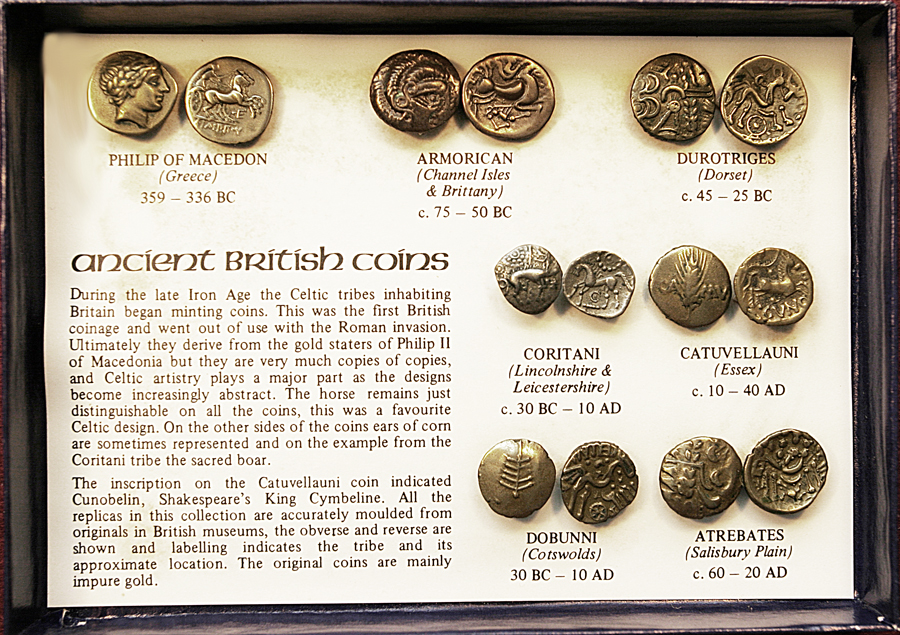
Numismatic Articles
Van Arsdell 2015b (Info)
Modern Celtic Fakes 8 – Replicas
By Robert Van Arsdell
Inexpensive replicas of Celtic coins have been readily available for over 35 years. These are usually sold at museum gift shops and are often attractively packaged with information about the coins.
The boxed set shown above was purchased in October 1979 at a museum in Leicester. The replicas are thick, cast plugs glued to the card. They show the coin images reasonably well. The gold staters were originally washed with “gold” paint, but this has tarnished over the years. There is no possibility these uniface plugs could be confused with genuine coins. They serve a purely educational purpose.
Sometime in the 1990s or early 2000s, lost-wax castings of individual coins began to appear. All the ones I have seen are clearly marked with incuse letters in the fields. Those with the letters WRL were produced by Westair Reproductions Ltd, those with an R are the products of H.I.S. Publications/Museum Reproductions.
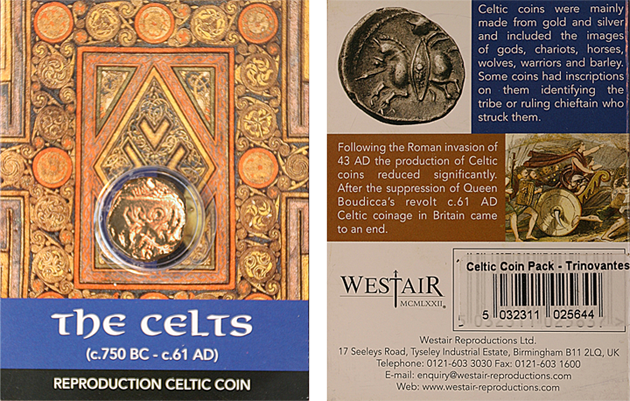
Westair is a specialist manufacturer of reproductions for sale in museum gift shops. They produce a wide range of replica objects. It appears the Celtic coin replicas they once sold are no longer made. It is possible, however, that museum gift shops may still have examples for sale.
Museum Reproductions (abbreviated MR in the photographs) is a specialist company producing replicas for individuals and organizations. Many finders of Celtic coins eventually sell their coins and the company makes lost-wax castings for them. Thus the finders have a memento to keep once the original coin has been passed on to new owners.
In the middle 2000s, some of these replicas appeared in auctions, offered as genuine coins. This was certainly not the manufacturers’ intended outcome, but for a time the replicas caused distress amongst collectors and students (info). Because the replicas are easily identified, however, the problem has dissipated somewhat in the ensuing years.
Despite the distress, the replicas do serve a real purpose. They’re generally more useful than dangerous, and deserve a place in numismatic work.
Collectors and scholars of Celtic coins often forget that the vast majority of people have never seen a Celtic coin. As a result, the public is deprived of a great opportunity to become interested in Celtic studies. The coin replicas help to fill this void.
Often, one is asked to give a talk or prepare a display about the Celts and their coins. Using genuine coins for these events is problematic. Replicas eliminate the security concerns over loss or damage. They can be glued onto display boards. They can be passed around to groups – especially to children. They can even be given away. Clearly, replicas have a place in promoting interest in Celtic studies.
Four gold staters
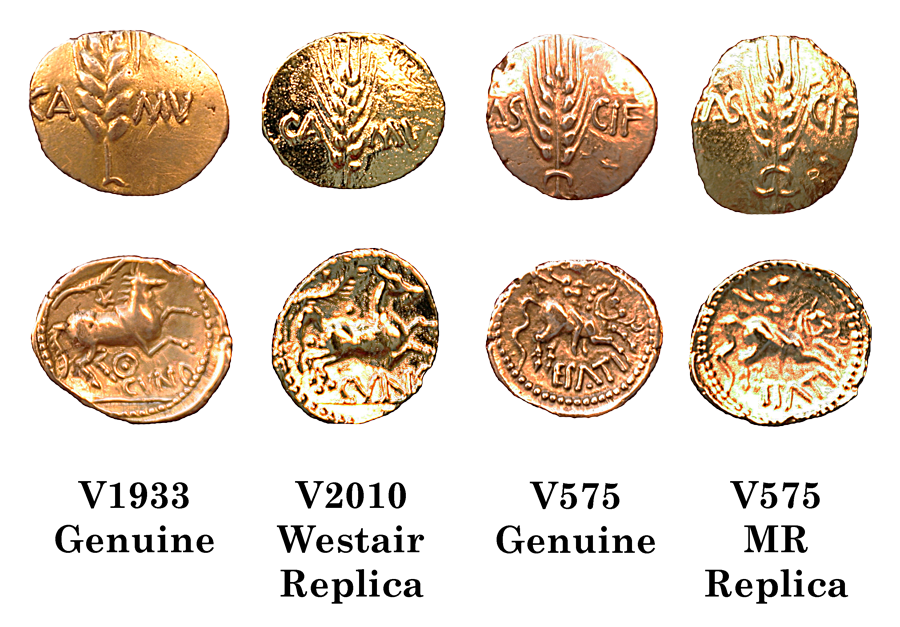
The four coins shown above demonstrate how easy it is to spot the replicas.
A genuine Cunobeline stater is shown with a Westair replica. Though the two are different types, the difference isn’t important to this discussion. The second pair includes a genuine Epaticcus stater and a Museum Reproductions replica.
In both cases, the replicas are shiny and bright – quite unlike the genuine coins. The image detail is much sharper in the original coins, and the colour is different. The replicas can be spotted without using a magnifying glass.
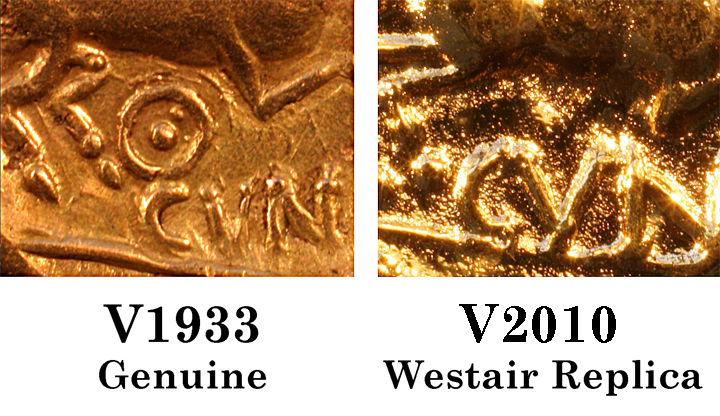
Upon magnification, the differences between the Cunobeline coins are made clear. The replica is unsharp, and the gold wash has made the details more obscure. The field of the replica is covered with little raised dots, produced by the casting process.
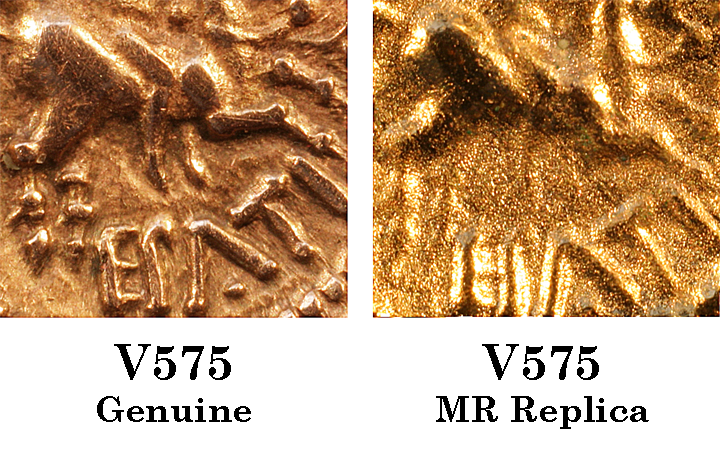
The Museum Reproductions replica of the Epaticcus stater shows the same exact differences. Neither replica should be mistaken for a genuine coin.
Can you spot a cast of a cast?
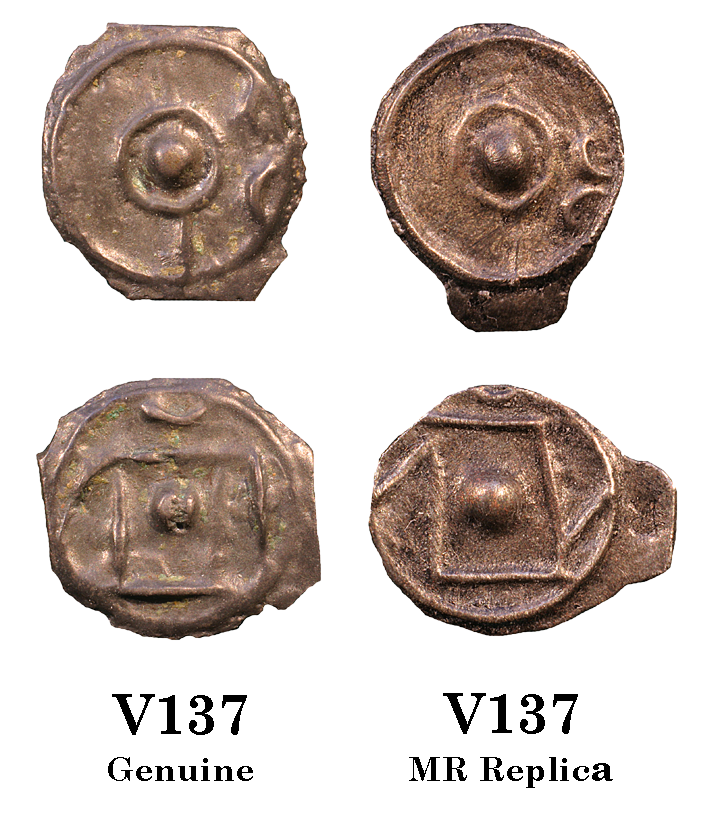
The one case where the replicas could be difficult involves coins where the original coin is cast – the Kentish Cast Bronze series, for example. The illustration shows a genuine V137 coin and a Museum Reproductions replica of the same type. The replica is admittedly a very good representation of the genuine type. However, the fields of the replica tend to be much more pebbled than the genuine piece. This effect can be seen in the photographs. The pebbled surface is unlike that seen on over fifty genuine Kentish coins I have examined.
One last diagnostic
The replicas weigh much less than genuine coins (weights in gms):
| Coin | Genuine | Replica |
| Cunobeline | 5.3571 | 3.7130 |
| Epaticcus | 5.3901 | 4.1270 |
| Cast Bronze | 1.2862 | 0.8979 |
The replicas are all cast in lightweight alloys and suffer the effects of differential shrinkage in the moulds. Although there are moulding materials that could counteract differential shrinkage, they have not been used to make these replicas.
End
